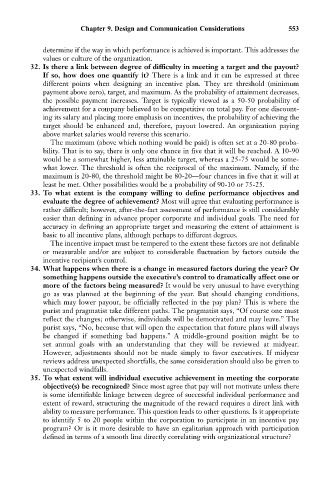Page 567 - Bruce Ellig - The Complete Guide to Executive Compensation (2007)
P. 567
Chapter 9. Design and Communication Considerations 553
determine if the way in which performance is achieved is important. This addresses the
values or culture of the organization.
32. Is there a link between degree of difficulty in meeting a target and the payout?
If so, how does one quantify it? There is a link and it can be expressed at three
different points when designing an incentive plan. They are threshold (minimum
payment above zero), target, and maximum. As the probability of attainment decreases,
the possible payment increases. Target is typically viewed as a 50-50 probability of
achievement for a company believed to be competitive on total pay. For one discount-
ing its salary and placing more emphasis on incentives, the probability of achieving the
target should be enhanced and, therefore, payout lowered. An organization paying
above market salaries would reverse this scenario.
The maximum (above which nothing would be paid) is often set at a 20-80 proba-
bility. That is to say, there is only one chance in five that it will be reached. A 10-90
would be a somewhat higher, less attainable target, whereas a 25-75 would be some-
what lower. The threshold is often the reciprocal of the maximum. Namely, if the
maximum is 20-80, the threshold might be 80-20—four chances in five that it will at
least be met. Other possibilities would be a probability of 90-10 or 75-25.
33. To what extent is the company willing to define performance objectives and
evaluate the degree of achievement? Most will agree that evaluating performance is
rather difficult; however, after-the-fact assessment of performance is still considerably
easier than defining in advance proper corporate and individual goals. The need for
accuracy in defining an appropriate target and measuring the extent of attainment is
basic to all incentive plans, although perhaps to different degrees.
The incentive impact must be tempered to the extent these factors are not definable
or measurable and/or are subject to considerable fluctuation by factors outside the
incentive recipient’s control.
34. What happens when there is a change in measured factors during the year? Or
something happens outside the executive’s control to dramatically affect one or
more of the factors being measured? It would be very unusual to have everything
go as was planned at the beginning of the year. But should changing conditions,
which may lower payout, be officially reflected in the pay plan? This is where the
purist and pragmatist take different paths. The pragmatist says, “Of course one must
reflect the changes; otherwise, individuals will be demotivated and may leave.” The
purist says, “No, because that will open the expectation that future plans will always
be changed if something bad happens.” A middle-ground position might be to
set annual goals with an understanding that they will be reviewed at midyear.
However, adjustments should not be made simply to favor executives. If midyear
reviews address unexpected shortfalls, the same consideration should also be given to
unexpected windfalls.
35. To what extent will individual executive achievement in meeting the corporate
objective(s) be recognized? Since most agree that pay will not motivate unless there
is some identifiable linkage between degree of successful individual performance and
extent of reward, structuring the magnitude of the reward requires a direct link with
ability to measure performance. This question leads to other questions. Is it appropriate
to identify 5 to 20 people within the corporation to participate in an incentive pay
program? Or is it more desirable to have an egalitarian approach with participation
defined in terms of a smooth line directly correlating with organizational structure?

